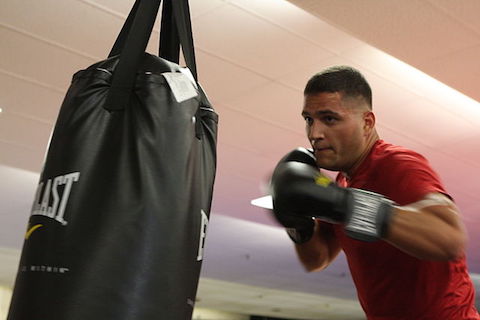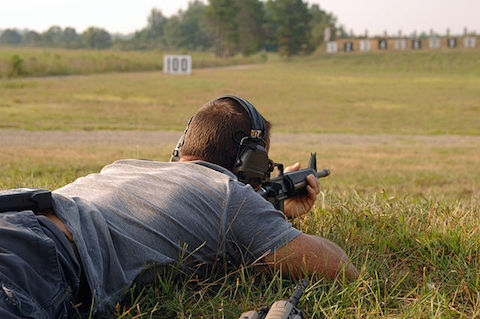
Are fists deadly weapons? Is a punch a lethal assault? You might be surprised!
Whenever police shoot a knife-wielding attacker there are cries of excessive force because the suspect “only had a knife.” Somehow the reality that a knife is in fact a dangerous weapon escapes many people; they see the gun as a more powerful tool and therefore only to be used against equally powerful tools.
The trouble with this line of thinking is that perceived power has little to do with how deadly something is. The knife, within its range, is likely more deadly than the firearm (as most knife experts will tell you.) In fact, in close quarters like an elevator I’m much more afraid of the knife than the firearm; I’m acquainted with what both can do and how to counter the weapons, and I’d much rather deal with the gun than the blade.
Because I know this, if someone were to attack me with a knife and I was forced to shoot that person I could articulate exactly why I did what I did: because I know how deadly the knife is and I can explain to others why it’s deadly.
Let’s take this even further: what about an attacker armed only with fists?
There seems to be a prevailing attitude in our society that a man should be able to take a punch. We don’t think of a punch as being all that serious an offense; after all, how many kids got punched by the playground bully and survived? Imagine being attacked by someone whose weapon is punching people; what are your options for defending yourself?
That depends, to a great extent, on what you know about fists and punching.
As it happens, fists are in fact dangerous weapons. As Dean Weingarten points out in this article, a punch to the face is in fact deadly force. Don’t believe me? According to the website onepunchhomicide.com, which tracks such things, just one county in Washington State — King County, where Seattle is located — has four to six one-punch homicides every year.
That’s one county in one state.
People are regularly killed by punches to the face, and the attacker isn’t always (in fact isn’t even usually) a big, strong individual. Watch this trailer from the One Punch Homicide documentary and be enlightened:
Sometimes it’s inadvertent (the puncher didn’t mean or want to kill the other person), while sometimes it’s not (the puncher intended to severely beat the other person, perhaps even to death). Either way, punches to the face often kill.
Knowing that, what are your defensive options?
Of course you first have to understand that the fist is a contact weapon, in the same category as a knife or club. Assuming you’re in sufficient shape, a good first step might be get some training in empty hands defense so that you can counter a punching attacker. Blauer Tactical’s Personal Defense Readiness might be one avenue for you to explore; Krav Maga might be another.
To a certain extent dealing with a puncher is somewhat easier than dealing with a knifer; his tools can’t as easily inflict life-threatening wounds when in very close quarters like the knife can. In order to make fists really dangerous, the attacker needs a little room to get good power into the punch. This is in contrast to using a knife which cuts on contact and is lethal against a wide range of targets without the user putting a lot of power into the cut.
Even “in the clench”, however, a punch is still dangerous; repeated short blows to the torso, even if they don’t have full power behind them, can knock the wind out of you or cause you sufficient abdominal pain to significantly affect your ability to defend yourself; when you’re winded or having difficulty standing up, the attacker can easily create enough distance to get in a serious punch to your head — and that, as you’ve seen, can be deadly.
What about those who aren’t up for that level of physical activity, or who know that sometimes things go horribly wrong and you need another force option — like a defensive handgun? In that case you’re going to need specific training for using the firearm when the threats is inside two arm’s reach, and Craig Douglas has one of the best courses around.
Let’s say you’ve taken the proper courses and you’ve learned how to control the close-in attack and managed to create enough distance to employ your firearm against what you know can be a lethal threat. What happens if you shoot?
Go back to the top, and think about how many times legitimate shootings have been publicly decried because the attacker “only” had a knife. Now imagine what the prosecutor, grand jury, judge, or the general public will say if you shoot someone who “didn’t have a weapon” and was “completely unarmed”.
Think about that long and hard.
If you understand that a punch to the face is often deadly, and that someone attacking you with fists therefore has the capability to inflict swift lethal force, you’ll understand why you need to defend yourself. If you understand that dynamic you can see how you’d need to articulate that reality to the jury. None of that means it’s going to be easy or that you’ll prevail. After all, societal attitudes aren’t easily changed with facts.
Is there an answer? Not an easy one, I’m afraid.
Even with well developed unarmed fighting skills you might end up needing to use lethal force against someone intent on punching you in the face. If that happens, you’ll need to be able to justify your actions in our legal system. You’ll need to read and watch the videos from the One Punch Homicide site, learn about how and why punches to the face often kill, and when you’re called to the stand explain what you knew about punching attacks and why that knowledge told you that you needed to use lethal force against your attacker.
Understand that you might still lose the case; people still take a dim view of folks who shoot “unarmed” people. That’s just the reality of things.
Anyone who tells you this kind of situation is cut-and-dry, or that it’s easy, is out of their mind.
-=[ Grant Cunningham ]=-
- Posted by Grant Cunningham
- On March 3, 2015



